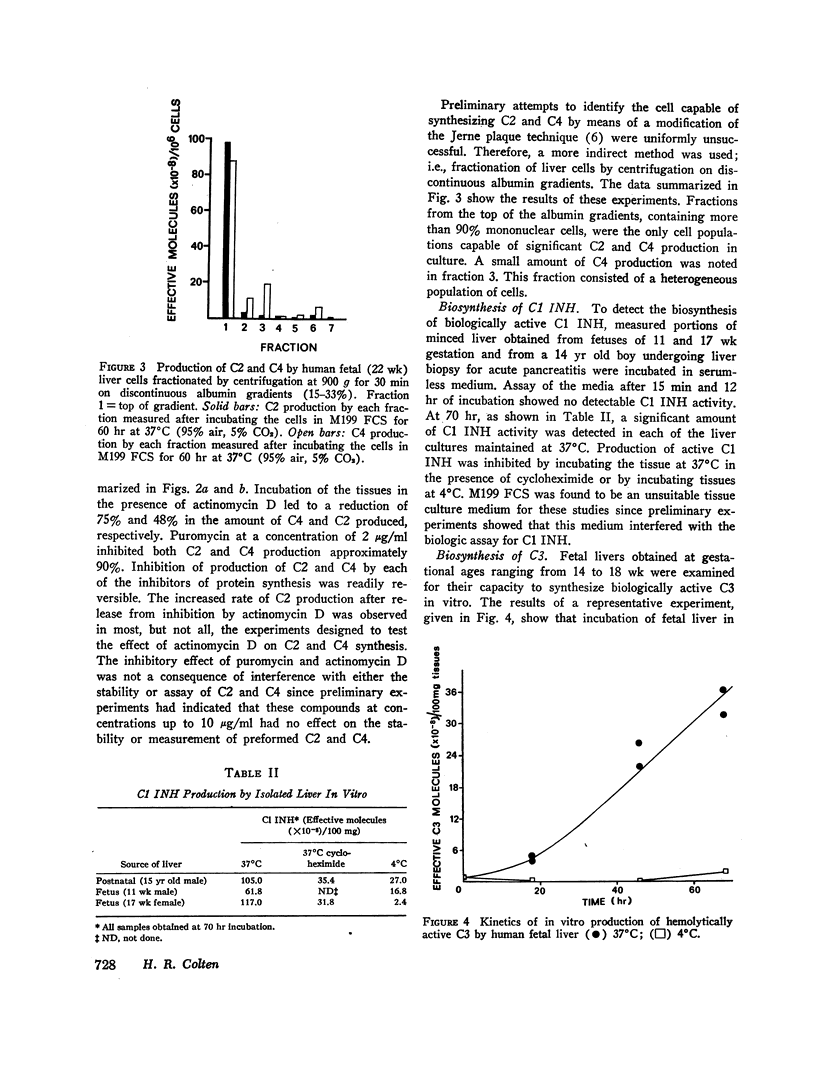Abstract
The human fetal liver is capable of synthesizing the biologically active form of the second (C2) and fourth (C4) components of complement as early as 8 wk after conception, and the inhibitor of C1 (C1 INH) as early as 11 wk after conception. Biologically active C3 was produced in vitro by fetal liver obtained at 14 wk gestation. These conclusions were based on the observations that isolated fetal livers produced biologically active C2, C3, C4, and C1 INH, that this production was temperature dependent and reversibly inhibited by well-known inhibitors of protein synthesis, and that 14C-labeled amino acids were incorporated into proteins immunochemically identical with these proteins. The data suggested that a large mononuclear cell was the cell type in the fetal liver that synthesized C2 and C4.
Full text
PDF





Images in this article
Selected References
These references are in PubMed. This may not be the complete list of references from this article.
- Adinolfi M., Gardner B., Wood C. B. Ontogenesis of two components of human complement: beta1E and beta1C-1A globulins. Nature. 1968 Jul 13;219(5150):189–191. doi: 10.1038/219189a0. [DOI] [PubMed] [Google Scholar]
- Alper C. A., Johnson A. M., Birtch A. G., Moore F. D. Human C'3: evidence for the liver as the primary site of synthesis. Science. 1969 Jan 17;163(3864):286–288. doi: 10.1126/science.163.3864.286. [DOI] [PubMed] [Google Scholar]
- August C. S., Merler E., Lucas D. O., Janeway C. A. The response in vitro of human lymphocytes to phytohemagglutinin and to antigens after fractionation on discontinuous density gradients of albumin. Cell Immunol. 1970 Dec;1(6):603–618. doi: 10.1016/0008-8749(70)90026-2. [DOI] [PubMed] [Google Scholar]
- Borsos T., Rapp H. J. Immune hemolysis: a simplified method for the preparation of EAC'4 with guinea pig or with human complement. J Immunol. 1967 Aug;99(2):263–268. [PubMed] [Google Scholar]
- Colten H. R., Gordon J. M., Borsos T., Rapp H. J. Synthesis of the first component of human complement in vitro. J Exp Med. 1968 Oct 1;128(4):595–604. doi: 10.1084/jem.128.4.595. [DOI] [PMC free article] [PubMed] [Google Scholar]
- Gigli I., Ruddy S., Austen K. F. The stoichiometric measurement of the serum inhibition of the first component of complement by the inhibition of immune hemolysis. J Immunol. 1968 Jun;100(6):1154–1164. [PubMed] [Google Scholar]
- Gitlin D., Biasucci A. Development of gamma G, gamma A, gamma M, beta IC-beta IA, C 1 esterase inhibitor, ceruloplasmin, transferrin, hemopexin, haptoglobin, fibrinogen, plasminogen, alpha 1-antitrypsin, orosomucoid, beta-lipoprotein, alpha 2-macroglobulin, and prealbumin in the human conceptus. J Clin Invest. 1969 Aug;48(8):1433–1446. doi: 10.1172/JCI106109. [DOI] [PMC free article] [PubMed] [Google Scholar]
- Johnson A. M., Alper C. A., Rosen F. S., Craig J. M. C1 inhibitor: evidence for decreased hepatic synthesis in hereditary angioneurotic edema. Science. 1971 Aug 6;173(3996):553–554. doi: 10.1126/science.173.3996.553. [DOI] [PubMed] [Google Scholar]
- Opferkuch W., Rapp H. J., Colten H. R., Borsos T. Immune hemolysis and the functional properties of the second (C2) and fourth (C4) components of complement. 3. The hemolytic efficiency of human and guinea pig C2 and C4. J Immunol. 1971 Apr;106(4):927–931. [PubMed] [Google Scholar]
- Rubin D. J., Borsos T., Rapp H. J., Colten H. R. Synthesis of the second component of guinea pig complement in vitro. J Immunol. 1971 Feb;106(2):295–303. [PubMed] [Google Scholar]



